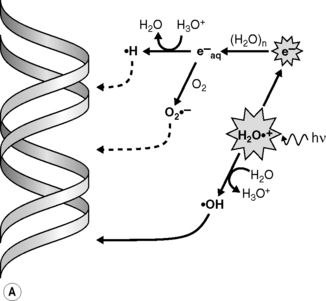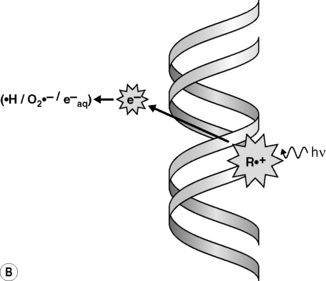Figure 17.1A). The initially ejected electrons (e−) may possess sufficient energy themselves to cause further ionizations until their energy is dissipated and they become solvated to give an aqueous electron (e−aq) and/or combine with other species to generate reducing species such as hydrogen atoms (H•) or superoxide (O2•−). Ionizing radiation is non-discriminatory in that all molecular species in a cell may be damaged. However, DNA is considered to be a key molecular target for the deleterious effects of ionizing radiation in cells. •OH radicals are highly reactive and, together with the less reactive reducing species, may damage DNA via the so-called indirect effect (


Figure 17.1 The (A) indirect and (B) direct effects of ionizing radiation. In the indirect effect, radiation interacts with water to produce hydroxyl free radicals (•OH) which, in turn, react with the DNA producing damage. In the direct effect, the radiation interacts directly with the DNA to produce damage. While both direct and indirect effects damage DNA, it is suggested that only indirect events happening within 2 nm of the DNA damage the DNA. Indirect effects dominate for low LET ionizing radiations. (The • ‘dot’ refers to an unpaired electron of a free radical, and the dashed lines reflect the lower reactivity of the reducing species with DNA, as compared to the high reactivity of •OH).
Through direct and indirect effects, radiation causes a wide range of damage in DNA, including strand breaks, base or sugar damage and cross-links between macromolecules (i.e. DNA–DNA or DNA–protein cross-links) (
• under a variety of experimental conditions, it is the relative level of induced or unrepaired DSBs that best correlates with cell killing
• a single DSB is lethal to yeast
• enzymatically produced DSBs (produced by inserting DNA restriction enzymes into cells) gives the same pattern of chromosome damage and lethality as radiation
• microbeam irradiation has shown the cell nucleus to be the most radiation sensitive site in the cell
• the extreme radiosensitivity of some mutant cell lines is due to defects in DSB repair.
Stay updated, free articles. Join our Telegram channel

Full access? Get Clinical Tree



